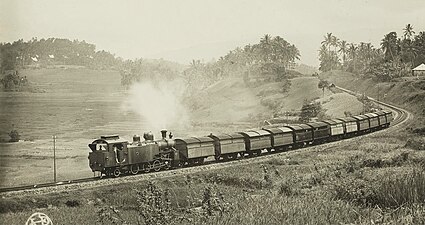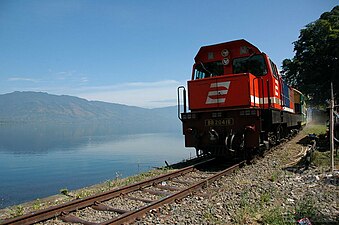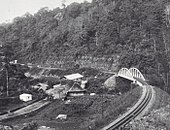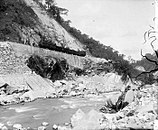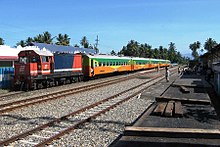Padang – Bukittinggi / Sawahlunto railway line
| Padang – Bukittinggi / Sawahlunto | |||||||||||||||||||||||||||||||||||||||||||||||||||||||||||||||||||||||||||||||||||||||||||||||||||||||||||||||||||||||||||||||||||||||||||||||||||||||||||||||||||||||||||||||||||||||||||||||||||||||||||||||||||||||||||||||||||||||||||||||||||||||||||||||||||||||||||||||||||||||||||||||||||||||||||||||||||||
|---|---|---|---|---|---|---|---|---|---|---|---|---|---|---|---|---|---|---|---|---|---|---|---|---|---|---|---|---|---|---|---|---|---|---|---|---|---|---|---|---|---|---|---|---|---|---|---|---|---|---|---|---|---|---|---|---|---|---|---|---|---|---|---|---|---|---|---|---|---|---|---|---|---|---|---|---|---|---|---|---|---|---|---|---|---|---|---|---|---|---|---|---|---|---|---|---|---|---|---|---|---|---|---|---|---|---|---|---|---|---|---|---|---|---|---|---|---|---|---|---|---|---|---|---|---|---|---|---|---|---|---|---|---|---|---|---|---|---|---|---|---|---|---|---|---|---|---|---|---|---|---|---|---|---|---|---|---|---|---|---|---|---|---|---|---|---|---|---|---|---|---|---|---|---|---|---|---|---|---|---|---|---|---|---|---|---|---|---|---|---|---|---|---|---|---|---|---|---|---|---|---|---|---|---|---|---|---|---|---|---|---|---|---|---|---|---|---|---|---|---|---|---|---|---|---|---|---|---|---|---|---|---|---|---|---|---|---|---|---|---|---|---|---|---|---|---|---|---|---|---|---|---|---|---|---|---|---|---|---|---|---|---|---|---|---|---|---|---|---|---|---|---|---|---|---|---|---|---|---|---|---|---|---|---|---|---|---|---|---|---|---|---|---|---|---|---|---|---|---|---|---|---|---|---|---|---|---|---|---|
|
|
|||||||||||||||||||||||||||||||||||||||||||||||||||||||||||||||||||||||||||||||||||||||||||||||||||||||||||||||||||||||||||||||||||||||||||||||||||||||||||||||||||||||||||||||||||||||||||||||||||||||||||||||||||||||||||||||||||||||||||||||||||||||||||||||||||||||||||||||||||||||||||||||||||||||||||||||||||||
| Route length: | originally 179.5 km, today 156 km | ||||||||||||||||||||||||||||||||||||||||||||||||||||||||||||||||||||||||||||||||||||||||||||||||||||||||||||||||||||||||||||||||||||||||||||||||||||||||||||||||||||||||||||||||||||||||||||||||||||||||||||||||||||||||||||||||||||||||||||||||||||||||||||||||||||||||||||||||||||||||||||||||||||||||||||||||||||
| Gauge : | 1067 mm ( cape track ) | ||||||||||||||||||||||||||||||||||||||||||||||||||||||||||||||||||||||||||||||||||||||||||||||||||||||||||||||||||||||||||||||||||||||||||||||||||||||||||||||||||||||||||||||||||||||||||||||||||||||||||||||||||||||||||||||||||||||||||||||||||||||||||||||||||||||||||||||||||||||||||||||||||||||||||||||||||||
| Maximum slope : |
Adhesion 30 ‰ rack originally 80 ‰, today 70 ‰ |
||||||||||||||||||||||||||||||||||||||||||||||||||||||||||||||||||||||||||||||||||||||||||||||||||||||||||||||||||||||||||||||||||||||||||||||||||||||||||||||||||||||||||||||||||||||||||||||||||||||||||||||||||||||||||||||||||||||||||||||||||||||||||||||||||||||||||||||||||||||||||||||||||||||||||||||||||||
| Minimum radius : | 150 m | ||||||||||||||||||||||||||||||||||||||||||||||||||||||||||||||||||||||||||||||||||||||||||||||||||||||||||||||||||||||||||||||||||||||||||||||||||||||||||||||||||||||||||||||||||||||||||||||||||||||||||||||||||||||||||||||||||||||||||||||||||||||||||||||||||||||||||||||||||||||||||||||||||||||||||||||||||||
| Rack system : | Riggenbach | ||||||||||||||||||||||||||||||||||||||||||||||||||||||||||||||||||||||||||||||||||||||||||||||||||||||||||||||||||||||||||||||||||||||||||||||||||||||||||||||||||||||||||||||||||||||||||||||||||||||||||||||||||||||||||||||||||||||||||||||||||||||||||||||||||||||||||||||||||||||||||||||||||||||||||||||||||||
|
|||||||||||||||||||||||||||||||||||||||||||||||||||||||||||||||||||||||||||||||||||||||||||||||||||||||||||||||||||||||||||||||||||||||||||||||||||||||||||||||||||||||||||||||||||||||||||||||||||||||||||||||||||||||||||||||||||||||||||||||||||||||||||||||||||||||||||||||||||||||||||||||||||||||||||||||||||||
The Padang – Bukittinggi / Sawahlunto railway , also known as the Padang Railway , is originally a 179.5 kilometer long railway line operated by Kereta Api Indonesia in Kapspur (1067 mm) on Sumatra , which connects Padang via Padang Panjang with Bukittinggi and Sawahlunto. The section from Padang Panjang to Bukittinggi is no longer in operation. 23 kilometers of the original coal transport line are equipped with the Riggenbach rack and pinion system .
history
In order to bring the high-quality hard coal from the mines in the interior of Sumatra to the coast for shipping and later for cement production, the state spoor roads ter Sumatra's West Coast built a railway from the coal mining area over the pass at Padang Panjang from 1889 to 1892. Overcoming the pass with relatively heavy trains and the difficult adhesion conditions made it necessary to use racks on gradients of 70 to 80 ‰ due to the tropical climate and the coal dust on the rails. The route was opened in several stages:
| Pulau Air- Panjang -Padang Panjang | July 1891 | 71 km |
| Padang Panjang - Bukittinggi | November 1891 | 19 km |
| Padang Panjang – Solok | July 1, 1892 | 53 km |
| Solok – Muarakalaban | October 1, 1892 | 23 km |
| Padang – Teluk Bayur | October 1, 1892 | 7 km |
| Muarakalaban – Sawahlunto | January 1, 1894 | 4 km |
| Lubukalung – Pariaman | 1908 | |
| Pariaman-Naras | 1911 | |
| Naras-Sungai Limau | 1917 |
In the mid-1980s, an expansion of the mines was considered in order to increase the production quantities to 1.7 million tons of coal per year. The biggest capacity bottleneck was the cogwheel route in the middle of the route. The track on the Kayu Tanam – Batutabal rack section was renovated, the existing cogwheel locomotives were repaired, a new maintenance workshop was set up and the railway staff were trained in the maintenance and servicing of locomotives and track.
At the end of 2002, the mining of coal in Ombilin was stopped, which meant that the coal railway from colonial times lost its right to exist.
In 2016, the 3-kilometer wing section from Duku to Minangkabau Airport was put into operation.
Route description
The Padnang Railway runs from Padang, the capital of West Sumatra, and the associated sea port Teluk Bayur (formerly Emmahaven) to Lubukalung through a plain that extends from the foot of the mountains to the coast. In Lubukalung the branches stitch line from Sungai Limau to that used for the transport of palm oil was used. This section has only been in operation as far as Pariaman since the 1990s. After Lubukalung, the train travels through hilly terrain to reach Kayu Tanam at 144 m above sea level after around 80 kilometers of adhesion. The route climbs on mixed adhesion and rack sections in the gorge of the Anai River to the 773 meters above sea level pass near Padang Panjang. This is where the most important structure on the route is located, the arch bridge over the Anei River with a gradient of 68 ‰. The branch line from Padang Panjang to Bukittinggi, on which no more trains ran in the 1990s, was also equipped with a rack.
From Padang Panjang train station, the Padang Railway goes down to Batutabal with racks. From there the route leads along the Singkarak Lake to Solok, where there is a depot that is no longer used . Solok was used as a storage place for spices during the Dutch colonial times. On the last section of the approximately 60-kilometer-long adhesion section, which leads via Muarakalaban to the Ombilin mines near Sawahlunto, greater inclines and tighter curve radii were necessary again. On December 17, 2005, Sawahlunto station was converted into a railway museum.
A branch line used to lead from Muarakalaban to Muaro. During the Japanese occupation in Indonesia , forced laborers had to extend the railroad to Pekanbaru . Due to the lightly built track, the route did not withstand the effects of the weather.
| Route section | Rack | adhesion | minimum curve radius |
Simplified route profile | ||
|---|---|---|---|---|---|---|
| Max. pitch | Max. gradient | Max. pitch | Max. gradient | |||
| Teluk Bayur – Padang – Kayu Tanam | - | - | 12 ‰ | 6 ‰ | 200 m | |
| Kayu Tanam – Kandang Ampat | 51 ‰ | - | 23 ‰ | - | 200 m | |
| Kandang Ampat – Padang Panjang | 70 ‰ | - | - | - | 150 m | |
| Padang Panjang – Koto Baru | 80 ‰ | - | 23 ‰ | - | 150 m | |
| Koto Baru – Bukittinggi | - | 67 ‰ | - | 23 ‰ | 200 m | |
| Padang Panjang – Batutabal | - | 50 ‰ | - | 13 ‰ | 200 m | |
| Batutabal – Solok | - | - | 10 ‰ | 10 ‰ | 200 m | |
| Solok – Muarakalaban | - | - | 15 ‰ | 20 ‰ | 150 m | |
| Muarakalaban – Sawahlunto | - | - | 30 ‰ | 18 ‰ | 150 m | |
Locomotives
| Locomotives | D 18 | E 10 | BB 204 |
|---|---|---|---|
| Numbering: | 101-103 | 104-125, 51-60 |
01-17 |
| Wheel alignment : | D1 'n4t | E h4vt | Bo'2'Bo ' |
| Gauge : | 1067 mm ( cape track ) | ||
| Length over buffers: | 10 691 mm | 10 085 mm | 13,500 mm |
| Trunnion Distance: | - | - | 7050 mm |
| Fixed wheelbase: | 2650 mm | 2840 mm | 2880 mm |
| Total wheelbase: | 6400 mm | 5000 mm | |
| Service mass: | 49.96 t | 51.98 t | 55 t |
| Top speed: | 60 km / h | ||
| Drive wheel diameter: | 1000 mm | 1000 mm | 895 mm |
| Impeller diameter: | 576 mm | - | 720 mm |
| Gear system : | Riggenbach | ||
| Drive gear diameter: | 975 mm | 975 mm | |
| LP cylinder diameter: | 450 mm | 450 mm | - |
| HD cylinder diameter: | |||
| Piston stroke: | 450 mm | 520 mm | - |
| Boiler overpressure: | 14 atm. | 14 atm. | - |
| Grate area: | 1.85 m² | 1.85 m² | - |
| Superheater area : | - | 30.8 m² | - |
| Total heating area: | 103.2 m² | 102.4 m² | - |
| Water supply: | 6.0 m³ | 5.0 m³ | - |
| Fuel supply: | 1.2 t | 1.2 t | 1700 liters |
When operations began, the European colonialists did not trust the local and Chinese locomotive personnel to operate machines with separate gear and adhesion drives , and they procured simple locomotives with firmly coupled gear and adhesion drives. These simple machines were not able to cope with the heavy traffic in the long run, so that from 1913 to 1965 the Swiss Locomotive and Machine Works (SLM) in Winterthur and the Machine Works Esslingen designed steam locomotives of the types D 10 and E 10 for mixed cog and wheel and Adhäsionsbetrieb System Winterthur delivered. The E 10.60 built in 1965 is the last steam locomotive to be built in Germany.
By 1984 diesel-electric SLM locomotives BB 204 for the rack section and mostly diesel-hydraulic locomotives from other manufacturers for the pure adhesion sections completely replaced steam traction. While the locomotive park was consistently renewed, the required route renovation and the adaptation of the maintenance infrastructure to the needs of the diesel locomotives initially failed to materialize.
Table: Padangbahn cogwheel locomotives
| Axis sequence |
designated voltage |
number | Construction year | Manufacturer | Factory no. | discarded | image |
|---|---|---|---|---|---|---|---|
| B1 'n2t | 27-30 | 1889 | Esslingen | 2269-2272 | after 1921 |

|
|
| 31-36 | 1891 | 2424-2429 | |||||
| ? | 1892 | 2512-2513 | |||||
| 37-41 | 1892 | 2515-2519 | |||||
| 42-45 | 1894 | 2634-2637 | |||||
| 56-57 | 1899 | 3068-3069 | |||||
| B n2t | 60 | 1892 | Esslingen | 2514 | after 1921 |

|
|
| B n2t | 61-62 | 1893 | Esslingen | 2589-2590 | after 1921 |

|
|
| 66-68 | 1896 | 2958-2960 | |||||
| 69 | 1902 | 3201 | |||||
| 70 | 1901 | 3177 | |||||
| 71 | 1904 | 3320 | |||||
| 1'B n2t | 63-65 | 1896 | Esslingen | 2802-2804, Saronno 82-84 |
after 1921 |

|
|
| D1 'n4t | D 18 | 101-102 | 1913 | Esslingen | 3678-3679 | after 1921 |

|
| 103 | SLM | ||||||
| E h4vt | E 10 | 104-112 | 1920 | SLM |

|
||
| 113-118 | Esslingen | 3986-3991 | 116 in the Jakarta
Transport Museum |
||||
| 119-121 | SLM | ||||||
| 122-125 | 1928 | Esslingen | 4214-4215, 4221-4222 |
||||
| 51-54 | 1963 | 5306-5309 | |||||
| 55-60 | 1965 | 5311-5316 | E 60 received | ||||
| Bo'2'Bo ' | BB 204 | 01-06 | 1982 | SLM | 5213-5218 |

|
|
| 07-08 | 1983 | 5278-5281 | |||||
| 09-10 | 1984 | 5627-5633 | |||||
| 11-17 | 1993 |
business
Tourist trains, which are pulled by a BB 204 locomotive, have been running on the Padang Railway on weekends and holidays since 2009. A regional train with 3rd class cars (“Ekonomi”) runs four times a day on the Padang-Pariaman section .
literature
- A. Kuntze: State railway on the west coast of Sumatra. In: Schweizerische Bauzeitung . Volume 17 (1891), issue 18 (E-Periodica.ch, PDF; 3.2 MB).
- Siegfried Abt: The new locomotives of the state railways on Sumatra (west coast) . In: Schweizerische Bauzeitung. Volume 78 (1921), Issue 7 (E-Periodica.ch, PDF; 2.1 MB).
- E-superheated steam locomotive composite tank locomotive for Sumatra. Built by the Swiss locomotive factory in Winterthur. In: The Locomotive . 21st year (June 1924), No. 6 (Anno Historische Austrian newspapers and magazines)
- Wolfgang Merz: The total renewal of the coal transport railway in West Sumatra. In: Swiss Railway Review . No. 6. Minirex, 1995, pp. 263-269.
- History of the railways in West Sumatra . In: Sumatra Railways Blogspot, January 13, 2016 (Indonesian)
